The giver
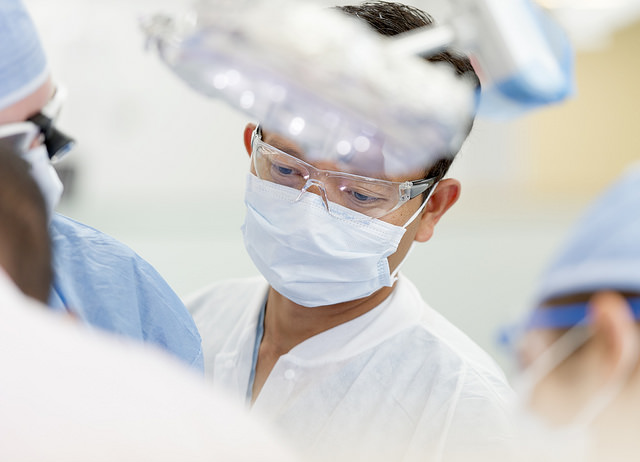
Just seven years after Don Le’s harrowing escape from Vietnam, a North Texas dental school decided to take a chance on the self-described “immigrant kid.” Now the 1998 alumnus opens up about how dentistry has changed his life.
“Extraction will not hurt at all,” the banner claimed. It veiled the derelict wagon, distinguished it from the others purporting some vital service to the villagers. Don Le, then a child, knew it was a lie. Every month the man in the wagon returned. Wheels sloshed through the mud as he rode into the village near Da Nang, Vietnam. He was never short on patients. The banner’s promise encouraged them.
Preparations foretold a different reality. Plant a tired wooden chair on the ground. Strap the patient to it. Retrieve homemade forceps. The tool is not adequate, but the man’s grip does not falter. Some pass out from the pain. A village elder succumbs to the blood loss. Yet something else is etched into Le’s memory.
“Watching his patients scream and fight back with their pain will never fade away from my mind,” Le writes in his 1993 application to Texas A&M University Baylor College of Dentistry.
Extraction was the only treatment that the self-taught “dentist” could offer his patients. There were others like him.
“These painful memories … scared me into keeping my teeth from becoming decayed and also made me angry at the government for not providing any dental care or education to the people,” Le wrote.
That government — the communist rulers of the Socialist Republic of Vietnam — unified north and south in July 1976, little more than three years after the last U.S. military unit pulled out of Vietnam. Le was 6 when Saigon, the capital of his home country, was given a new name: Ho Chi Minh City, an ode to the communist revolutionary.
In cramped, wooden fishing boats the people fled. For 20 years to follow, waves of people fled by the hundreds of thousands, packed on board the often-unseaworthy vessels. They were easy prey for pirates. Storms pummeled some of the boats. More insidious still were the leaks. A calm sea could hold immeasurable danger for a craft on the verge of sinking. One boat departed from Saigon in late 1984 with 108 souls on board. Among them: Le, then 14, and his sister, two brothers, mother and father, a former officer in the South Vietnamese Army.
In 1982, after six years of imprisonment, his father had escaped from one of the notorious re-education camps designed to force South Vietnamese men, religious leaders and military members into learning the ways of their new government. Those who didn’t die from the grueling labor struggled to hold onto morale. His father lived in hiding for nearly two years before it was safe to send for his family, who at that point had moved from their village to the city historically known as Saigon where there was safety in anonymity.
Punishment for the defection would be swift and unforgiving. To avoid that fate, Le’s father arranged for his family’s passage, though they weren’t sure of the destination. Swathed in the cover of darkness they tiptoed aboard the craft in flip-flops, jeans and T-shirts.
“In the boat we ate very little, but we were not hungry,” Le recalls. “We had a little soup, something just to survive.”
They were aiming for Indonesia, where the U.N. had set up a sprawling refugee camp on Galang Island. They charted a course along the South China Sea, but inexperience threw them adrift.
A ConocoPhillips drilling rig in Indonesian waters served as a waypoint. Before guiding them to the shores of Galang, a Texas oil worker doled out 108 sodas and ham sandwiches, each snug in shiny aluminum foil.
“In Vietnam all I knew was that they used foil paper to wrap cigarettes,” Le says. “I thought, ‘That’s expensive, this man must be rich.’ We had seen Coca-Cola cans before, but we had never seen that many at one time. Everybody had one. “You go, ‘Wow, this is the beginning of heaven here.’ And when you get to the camp it’s a different story.”
For nearly two years they waited at Galang. Over meals of Spam and hot dogs, they anticipated news of their application for U.S. asylum. If they let it, boredom and uncertainty could take hold within the wooden confines of their temporary home. Yet it was far better than what they left behind.
On Dec. 16, 1986, Le and his family arrived in Houston, where a new life awaited. In January 1987, Le, then 17, enrolled at Lamar High School. He was skinny, dark and spoke barely a lick of English. His guidance counselor knew he had missed most of middle school. She had some advice for him: aim for his GED, and set his sights on a factory job as an assembly worker. Le didn’t listen.
YOU CAN HEAR THE EXCITEMENT IN LE’S VOICE as he talks about Dr. James Nguyen Thang, a mentor 30 years his senior who fled Saigon a decade before him.
“He was my dentist when I first came to America,” he says. Now Le, a 1998 Texas A&M Baylor College of Dentistry alumnus, is Thang’s dentist. “Some of the fillings in my mouth he did, and some of the fillings in his mouth, I did,” Le says, strolling through the gleaming new foyer at the University of Texas School of Dentistry at Houston. He points to the gray block, one of just a select few on this tribute to the school’s high-level donors, inscribed with the words “The Nguyen Thang Family Professorship in Oral Surgery.” Le had a hand in convincing Thang of the value of such a gift: $100,000 pledged in honor of Thang’s son, Chris, a resident in UTSD’s oral surgery program and a 2012 graduate whom Le taught. Le’s name fills another block on the donor wall, evidence of previous contributions of his own.
“One thing I always see with gift giving: You’re always satisfied,” Le says, leaning on one of the bays in the Urgent Care Clinic at the Houston dental school, where he spends every Wednesday as a volunteer faculty member. He’s taken pause from hopping stool to stool, coaching students over the steady whir of high-speed handpieces.
“As for income, you always want a little bit more. It’s never enough,” he continues. “With giving, you never go home and say, ‘I gave a dollar. Maybe I should give $1.50.’ Every dollar you give, you always feel full. It’s always enough to give.”
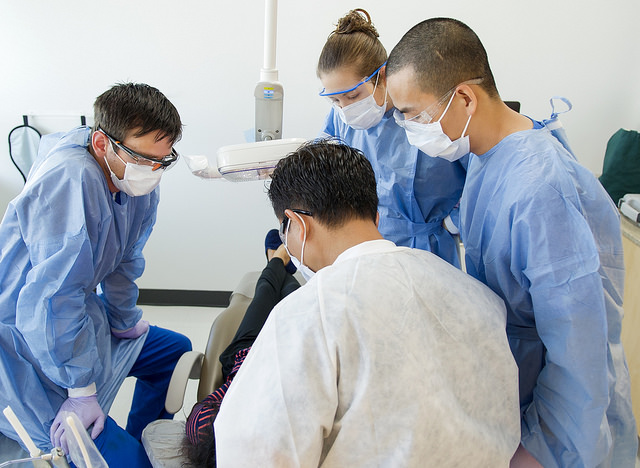
In December 2012, Le and his wife, Cindy, pledged $50,000 to Texas A&M Baylor College of Dentistry toward the creation of a scholarship, which will be used to award one student a year with $2,500. Earlier that year, they teamed up with two couples — all UT dental alumni — donating to the Houston school as part of a $100,000 endowed general dentistry professorship. He witnesses the impact of that gift every time he steps foot on the campus, part of UT Health Science Center at Houston.
Giving is easy, natural. Le sees a need, determines a practical solution to fill it and encourages others to do the same.
“There’s always concern for others,” says Dr. Richard Bebermeyer, retired chair of the school’s general practice and dental public health department, who was the first to be honored with the endowed professorship.
“There are ideas for what can help the school; for example, if we had a certain piece of imaging equipment, then the Urgent Care Clinic could be better. Don’s line to the dean is, ‘How can I help make this happen?’”
Most of Le’s students don’t know about his gifts to the school. Some are not even aware that he teaches on a volunteer basis. He prefers it that way.
Matthew Massey, a fourth-year dental student at UTSD, has worked with Le in the clinic several times, and the topic has come up during interludes between patient appointments.
“We should start with a minimum of one day a month volunteering,” says Massey, who plans to go into private practice in Connor, Texas, after a stint in the Army Dental Corps. “It’s definitely something that I’m going to do. Dr. Le makes it easier to give back.”
 IN 1998, Dr. Dieter Moya had just joined an oral and maxillofacial surgery practice and was looking for referring dentists. One practice — Centro Dental — peaked his curiosity. It was located in Spring Branch, a predominantly Hispanic area of Houston. When Moya walked into the waiting room, he noticed the TV set to a Spanish station. Then he met the owner. Moya, who as a child immigrated to the U.S. from Mexico City, mused at the irony.
IN 1998, Dr. Dieter Moya had just joined an oral and maxillofacial surgery practice and was looking for referring dentists. One practice — Centro Dental — peaked his curiosity. It was located in Spring Branch, a predominantly Hispanic area of Houston. When Moya walked into the waiting room, he noticed the TV set to a Spanish station. Then he met the owner. Moya, who as a child immigrated to the U.S. from Mexico City, mused at the irony.
“Why would a Vietnamese guy put a Spanish name on his dental clinic?” says Moya. He had more questions for Le.
Why didn’t he choose to set up a practice in Dallas after graduating? There were so many burgeoning locales surrounding his dental school. Why not stay there?
“His thought was that it was very easy to make it in those areas. The challenging part would be to make it in an area where his skills set and his hands were more needed,” says Moya. “His plan was always to set his office in an area where he could give back. Whether it was Vietnamese or Hispanic, he felt like he owed it to the minority to give back to them.”
Business was tough those first years. There weren’t enough patients to see. Those who weren’t covered through Medicaid often couldn’t pay. Le treated them anyway. Some brought food, depositing favorite family dishes at the front desk.
“He was OK. He knew that was where he needed to be,” Moya recalls. “That place is his calling.”
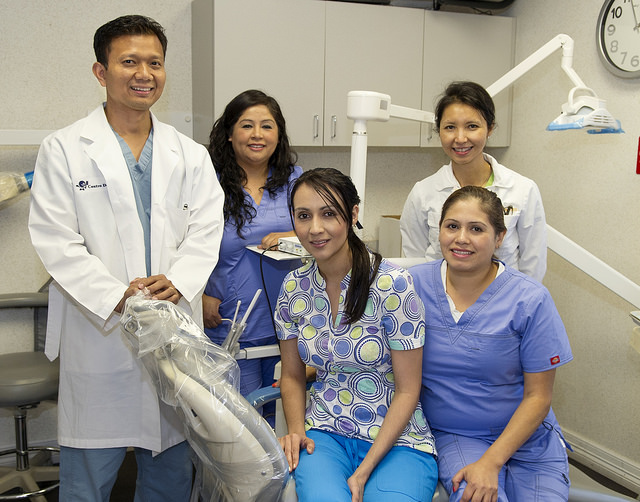
Not all Spring Branch residents immediately took to Le.
“The patients wanted a Hispanic dentist at first,” says Gabriela Rodriguez, who has worked as a dental assistant at Le’s practice since it opened more than 15 years ago. With time, Le’s Spanish improved, and his jokes won over patients.
“Now they keep coming back,” Rodriguez says. Patients whom they treated as children are now grown. Stories shared over the years may change, but many faces are the same.
The space, which Le has leased for 16 years, is bright yet unassuming. At 1,500 square feet, there is room for three dental operatories, Le and five employees — including his brother, Kevin, a dental hygienist. Part-time associates Drs. Mimi Chow and Trinh Nguyen treat patients two days a week. Paper charts line the shelves behind the front desk, where Gisela Rodriguez, Gabriela’s sister, greets patients with a broad smile.
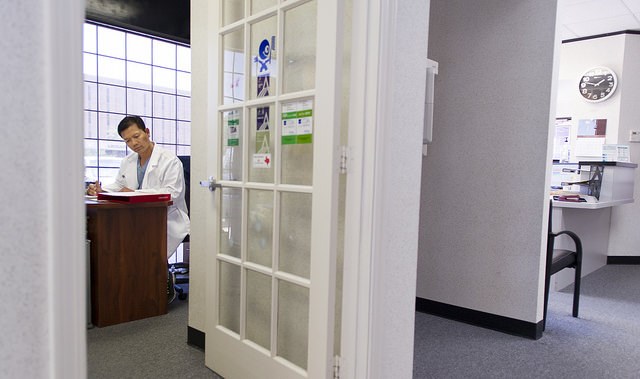 Le has kept his office small by choice. Dentistry is the backbone, but instead of pouring earnings into a practice expansion, capital is directed into other ventures, including banking and real estate development. Le now sits on the board of directors for The MINT National Bank in Kingwood, Texas. He invested in the fledgling bank at the height of the 2008 financial crisis because he saw its potential as a community-based lender that could cater to Houston’s Vietnamese population. Wicker baskets in his office are filled with blue prints from real estate projects.
Le has kept his office small by choice. Dentistry is the backbone, but instead of pouring earnings into a practice expansion, capital is directed into other ventures, including banking and real estate development. Le now sits on the board of directors for The MINT National Bank in Kingwood, Texas. He invested in the fledgling bank at the height of the 2008 financial crisis because he saw its potential as a community-based lender that could cater to Houston’s Vietnamese population. Wicker baskets in his office are filled with blue prints from real estate projects.
Acumen in math and science has allowed Le to excel in these fields.
“As an immigrant kid when you don’t know how to speak the language, reading and writing is much harder than math and science,” says Le, who graduated in the top 10 percent of his class at Lamar and was accepted to the University of Texas at Austin, where he studied math and physics before leaving after his junior year to attend Texas A&M Baylor College of Dentistry.
“I always tell him he’s the American dream to the 10th power,” says Moya. “Nothing has ever been given to this guy. There is no inheritance; there are no hand-me-downs. Everything that he has today he has worked his tail off to be able to get. And he has been so good about sharing his good fortune with others.”
LE’S FIRST CHANCE TO RETURN TO VIETNAM came in 1997 as a third-year dental student. Nights stretched on in the lab as he worked to raise travel funds for the trip. For a fee, he completed wax preparations for the gold inlays used in senior students’ board exams.
Then Le bought a ticket, packed a bag and boarded a flight bound for Ho Chi Minh City, where he planned to meet oral surgeons for Operation Smile, a dental mission devoted to treating patients with cleft lip and cleft palate. For five weeks, he assisted surgeons, translated, took patient photos and even completed sutures.
“I was so excited for the trip,” Le recalls. “When the airplane was about to land, I looked down and saw all the tin roofs. Some of the roofs were rusted. It was the same as the movies, like with ‘Missing in Action’ with Chuck Norris.
“People cry when they land. It is the place you left, the place where you thought you would never have the chance to go back,” says Le. “That was an experience.”
Le’s wife, Cindy, also left Vietnam as a child. The couple has chosen to return several times with their three children to acquaint them firsthand with living conditions in their home country. The Les vividly recall the overcrowding at a children’s hospital in Ho Chi Minh City.
“Patients would lie out in the hospital grounds and hallways because they didn’t have enough room,” Cindy Le says.
IT HAS BEEN NEARLY 40 YEARS since the Communist Party of Vietnam came into power, but dental problems still plague a majority of the southeastern Asian country’s 93 million citizens.
According to a 2010 article published in BMC Oral Health and now archived in the National Library of Medicine, the average adult surveyed in southern Vietnam had two missing teeth beginning at age 20, increasing to 16 missing teeth by age 80. A high number of missing teeth coupled with a small number of fillings points to the prevalent course of treatment, one that has haunted Le since childhood: extraction.
The World Health Organization lists several factors that contribute to the pervasive oral health problems in Vietnam: low fluoride levels in the water supply; increased consumption of refined sugars; dentists who cluster into urban areas, leaving patients in rural locations largely untreated; and poor dental hygiene.
Le’s dental school application essay is now two decades old, but his words mirror that finding.
“Parents did not teach, nor force their children to brush,” Le wrote. “Almost no children had a toothbrush until the age of 16 or 17 years.
“Many people … mistakenly believed that they need not brush their teeth at a young age, since the baby teeth will be replaced at adulthood. As a result, many adults lose teeth prematurely and must chew foods with their naked gums.”
In late June 2014, Le returned to Vietnam once again with his wife and children. His packing list included boxes of toothbrushes, toothpaste and oral hygiene supplies. Since he didn’t travel with a dental mission group, he was not permitted to treat patients. But he did what he could. Many of the toothbrushes went to children, so that they wouldn’t have to wait until their teenage years to start taking care of their teeth.
Asked what fuels him to return to the country that drove him away all those years ago, and why he wants to help, Le has an immediate answer: “It’s a gift,” he says. “It’s my roots.
Roots of success

RAMBO IS THE FIRST TO GREET US. After a couple good- natured barks, the family’s German shepherd hunkers down next to his dog house, which is planted between towering concrete pillars underneath the family home. The three Le children peer down at us — this writer and the college photographer — through a wall of glass. For the moment, 14-year-old Allison and 11-year-old Andrea, both state-ranked tennis players, are between lessons. They don’t travel far to practice. The court sits caddy-corner to the house. It’s the first thing the Le family built after they purchased the 3-acre property. Years passed before they demolished the 2,000 square-foot, one-bedroom house and had one five times larger built in its place.
They designed the home, and every inch of the contemporary-style space exudes the Les’ personal touches. The farthest reaches of the white and black marble hallways reveal expanses of light, bringing the lushness of the outdoor bamboo gardens inside. It is in this setting that Don and Cindy Le manage their family’s busy life.
“She’s really the one doing all the work,” he says, grinning in Cindy’s direction. Together they strive to raise well- balanced, socially conscious children.
“Every day we teach our children the best we can,” says Cindy. “We all make mistakes; we’re all learning. Everything we do, I tell the children, ‘Write it down, and then years and years from now you can go back and read it.’ We get better as we go.”
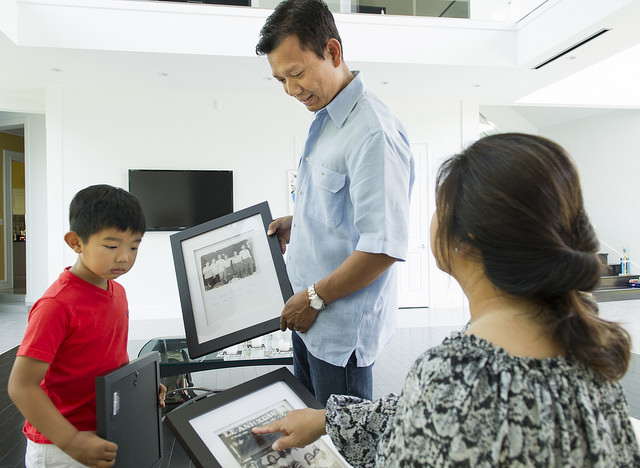
The great room is a hub of activity. During this visit, the family congregates on the sectional sofa, flanked by two chairs, 5-year-old Austin’s rocking horse and a dry erase easel. On it the girls have outlined their strategy for an upcoming doubles match at the International Tennis Grand Slam. The tournament banner hangs on a door across the room.
Le carries in an armload of framed 8x10s. He’s just reconnected with sixth-grade schoolmates on Facebook, and he printed these photos from a friend’s profile. In faded sepia and black-and-white tones, the kids are lined up for their class photo. Some of their pants are too short, and more than one pair of shoes has a gaping crevasse where rubber binding should be. Le is easy to spot, front and center, beaming ear to ear.
Andrea studies the photo. “You came from that to what we have right now,” she says to him. “When you work hard, you will get somewhere,” she adds, her gaze fixed on the image. “In those pictures, he didn’t have much, but he worked hard.”
It’s true that Le perpetually has a plan. It’s a crucial piece of his odds-busting, American dream success story. And in typical fashion, he deflects the focus from himself.
“All of this happened because of Baylor College of Dentistry,” Le says. “Without dentistry we wouldn’t have had a chance to invest. We wouldn’t have any of this. It all came from 3302 Gaston Avenue.”
This article originally appeared in the Fall/Winter 2014 Baylor Dental Journal.